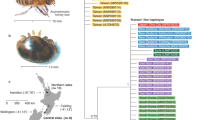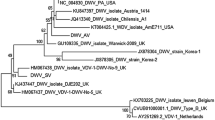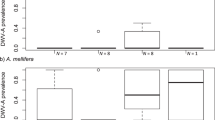Abstract
A successful control or eradication programme using biological control or genetically-mediated methods requires knowledge of the origin and the extent of wasp genetic diversity. Mitochondrial DNA variation in the native and invaded range of the social wasp Vespula germanica was used to examine intra-specific genetic variation and invasive source populations. We also examined wasps for the presence of four viruses found in honey bees: Acute bee paralysis virus, Deformed wing virus, Israeli acute paralysis virus and Kashmir bee virus. German wasps showed reduced genetic diversity in the invaded range compared to that of their native range. Populations in the introduced range are likely to have arrived from different source populations. All four viral honey bee pathogens were found in V. germanica, although they varied in their distribution and strain. Multiple introductions of German wasps have occurred for most invaded regions, though some populations are genetically homogenous. The differing locations of origin will guide researchers searching for biocontrol agents and the reduced genetic diversity may make these wasps a potentially viable target for control via gene drives.






Similar content being viewed by others
References
Anderson RM, May RM (1979) Population biology of infectious disease: part I. Nature 280:361–367
Archer ME (1998) The world distribution of the Euro-Asian species of Paravespula (Hym., Vespinae). Entomol Mon Mag 134:279–284
Beggs JR, Rees JS, Harris RJ (2002) No evidence for establishment of the wasp parasitoid, Sphecophaga vesparum burra (Cresson) (Hymenoptera: Ichneumonidae) at two sites in New Zealand. N Z J Zool 29:205–211
Beggs JR, Rees JS, Toft RJ et al (2008) Evaluating the impact of a biological control parasitoid on invasive Vespula wasps in a natural forest ecosystem. Biol Control 44:399–407
Beggs JR, Brockerhoff EG, Corley JC et al (2011) Ecological effects and management of invasive alien Vespidae. Biocontrol 56:505–526
Bergstrom DM, Lucieer A, Kiefer K et al (2009) Indirect effects of invasive species removal devastate World Heritage Island. J Appl Ecol 46:73–81
Burt A (2003) Site-specific selfish genes as tools for the control and genetic engineering of natural populations. Proc R Soc B Biol Sci 270:921–928
Cameron SA, Lozier JD, Strange JP et al (2011) Patterns of widespread decline in North American bumble bees. Proc Natl Acad Sci 108:662–667
Clapperton BK, Alspach PA, Moller H, Matheson AG (1989) The impact of common and German wasps (Hymenoptera: Vespidae) on the New Zealand beekeeping industry. N Z J Zool 16:325–332
Corin SE, Lester PJ, Abbott KL, Ritchie PA (2007) Inferring historical introduction pathways with mitochondrial DNA: the case of introduced Argentine ants (Linepithema humile) into New Zealand. Divers Distrib 13:510–518
Crosland MW (1991) The spread of the social wasp, Vespula germanica, in Australia. N Z J Zool 18:375–388
Dainat B, Evans JD, Chen YP et al (2012) Dead or alive: Deformed wing virus and Varroa destructor reduce the life span of winter honeybees. Appl Environ Microbiol 78:981–987
Dearden PK, Gemmell NJ, Mercier OR et al (2017) The potential for the use of gene drives for pest control in New Zealand: a perspective. J R Soc N Z. https://doi.org/10.1080/03036758.2017.1385030
Dobelmann J, Loope KJ, Wilson-Rankin E et al (2017) Fitness in invasive social wasps: the role of variation in viral load, immune response and paternity in predicting nest size and reproductive output. Oikos 126:1208–1218
Donovan BJ, Read PEC (1987) Attempted biological control of social wasps, Vespula spp., (Hymenoptera: Vespidae) with Sphecophaga vesparum (curtis) (Hymenoptera: Ichneumonidae) in New Zealand. N Z J Zool 14:329–335
Dowling DK, Tompkins DM, Gemmell NJ (2015) The Trojan Female Technique for pest control: a candidate mitochondrial mutation confers low male fertility across diverse nuclear backgrounds in Drosophila melanogaster. Evol Appl 8:871–880
Drury DW, Dapper AL, Siniard DJ et al (2017) CRISPR/Cas9 gene drives in genetically variable and nonrandomly mating wild populations. Sci Adv 3:e1601910
Dupas S, Carton Y, Poiriè M (2003) Genetic dimension of the coevolution of virulence-resistance in Drosophila—parasitoid wasp relationships. Heredity 90:84–89
Edwards E, Toft R, Joice N, Westbrooke I (2017) The efficacy of Vespex® wasp bait to control Vespula species (Hymenoptera: Vespidae) in New Zealand. Int J Pest Manag 63:266–272
Esvelt KM, Smidler AL, Catteruccia F, Church GM (2014) Concerning RNA-guided gene drives for the alteration of wild populations. Elife 3:1–21
Evison SEF, Roberts KE, Laurenson L et al (2012) Pervasiveness of parasites in pollinators. PLoS ONE 7:e30641
Gegear RJ, Otterstatter MC, Thomson JD (2006) Bumble-bee foragers infected by a gut parasite have an impaired ability to utilize floral information. Proc R Soc B Biol Sci 273:1073–1078
Genersch E, Yue C, Fries I, De Miranda JR (2006) Detection of Deformed wing virus, a honey bee viral pathogen, in bumble bees (Bombus terrestris and Bombus pascuorum) with wing deformities. J Invertebr Pathol 91:61–63
Goolsby JA, De Barro PJ, Makinson JR et al (2006) Matching the origin of an invasive weed for selection of a herbivore haplotype for a biological control programme. Mol Ecol 15:287–297
Grodowitz MJ, Center TD, Cofrancesco AF, Freedman JE (1997) Release and establishment of Hydrellia balciunasi (Diptera: Ephydridae) for the biological control of the submersed aquatic plant Hydrilla verticillata (Hydrocharitaceae) in the United States. Biol Control 9:15–23
Gruber MAM, Cooling M, Baty JW et al (2017) Single-stranded RNA viruses infecting the invasive Argentine ant, Linepithema humile. Sci Rep 7:3304
Hammond A, Galizi R, Kyrou K et al (2016) A CRISPR-Cas9 gene drive system targeting female reproduction in the malaria mosquito vector Anopheles gambiae. Nat Biotechnol 34:78–83
Hasegawa M, Kishino H, Yano T (1985) Dating of the human-ape splitting by a molecular clock of mitochondrial DNA. J Mol Evol 22:160–174
Hoffmann BD (2011) Eradication of populations of an invasive ant in northern Australia: successes, failures and lessons for management. Biodivers Conserv 20:3267–3278
Jones RAC, Coutts BA (2015) Spread of introduced viruses to new plants in natural ecosystems and the threat this poses to plant biodiversity. Mol Plant Pathol 16:541–545
Keane RM, Crawley MJ (2002) Exotic plant invasions and the enemy release hypothesis. Trends Ecol Evol 17:164–170
Lester PJ, Brown SDJ, Edwards ED et al (2014a) Critical issues facing New Zealand entomology. N Z Entomol 37:1–13
Lester PJ, Gruber MAM, Brenton-Rule EC et al (2014b) Determining the origin of invasions and demonstrating a lack of enemy release from microsporidian pathogens in common wasps (Vespula vulgaris). Divers Distrib 20:964–974
Lester PJ, Bosch PJ, Gruber MAM et al (2015) No evidence of enemy release in pathogen and microbial communities of common wasps (Vespula vulgaris) in their native and introduced range. PLoS ONE 10:e0121358
Levitt AL, Singh R, Cox-Foster DL et al (2013) Cross-species transmission of honey bee viruses in associated arthropods. Virus Res 176:232–240
MacIntyre P, Hellstrom J (2015) An evaluation of the costs of pest wasps (Vespula species) in New Zealand. Department of Conservation and Ministry for Primary Industries, Wellington
Masciocchi M, Corley J (2013) Distribution, dispersal and spread of the invasive social wasp (Vespula germanica) in Argentina. Austral Ecol 38:162–168
Masciocchi M, Pereira AJ, Corley JC (2016) Local dynamics of worker activity of the invasive Vespula germanica and V. vulgaris (Hymenoptera: Vespidae) wasps in Argentina. Ecol Entomol 41:105–111
McFadden AMJ, Tham K-M, Stevenson M et al (2014) Israeli acute paralysis virus not detected in Apis mellifera in New Zealand in a national survey. J Apic Res 53:520–527
McMahon DP, Natsopoulou ME, Doublet V et al (2016) Elevated virulence of an emerging viral genotype as a driver of honeybee loss. Proc R Soc B Biol Sci. https://doi.org/10.1098/rspb.2016.0811
Meeus I, Brown MJF, De Graaf DC, Smagghe G (2011) Effects of invasive parasites on bumble bee declines. Conserv Biol 25:662–671
Meeus I, de Miranda JR, de Graaf DC et al (2014) Effect of oral infection with Kashmir bee virus and Israeli acute paralysis virus on bumblebee (Bombus terrestris) reproductive success. J Invertebr Pathol 121:64–69
Moller H, Tilley J, Thomas B, Gaze P (1991) Effect of introduced social wasps on the standing crop of honeydew in New Zealand beech forests. N Z J Zool 18:171–179
Niu J, Meeus I, Smagghe G (2016) Differential expression pattern of Vago in bumblebee (Bombus terrestris), induced by virulent and avirulent virus infections. Sci Rep 6:1–9
Oksanen J, Blanchet FG, Friendly M, Kindt R, Legendre P, McGlinn D, Minchin PR, O’Hara RB, Simpson GL, Solymos P, Stevens MHH, Szoecs E, Wagner H (2018) Vegan: community ecology package. R package version 2.5-1. https://CRAN.R-project.org/package=vegan
Potts SG, Biesmeijer JC, Kremen C et al (2010) Global pollinator declines: trends, impacts and drivers. Trends Ecol Evol 25:345–353
Prost S, Anderson CNK (2011) TempNet: a method to display statistical parsimony networks for heterochronous DNA sequence data. Methods Ecol Evol 2:663–667
R Core Team (2018) R: a language and environment for statistical computing. R Foundation for Statistical Computing, Vienna, Austria. https://www.R-project.org/
Rejmánek M, Pitcairn MJ (2002) When is eradication of exotic pest plants a realistic goal? In: Veitch CR, Clout MN (eds) Turning the tide: the eradication of invasive species. IUCN Species Survival Commission, Gland, pp 249–253
Sakai AK, Allendorf FW, Holt JS et al (2001) The population biology of invasive species. Annu Rev Ecol Syst 32:305–332
Santamaria J, Villalobos EM, Brettell L et al (2017) Evidence of Varroa-mediated Deformed wing virus spillover in Hawaii. J Invertebr Pathol. https://doi.org/10.1016/j.jip.2017.11.008
Schroeder DC, Martin SJ (2012) Deformed wing virus: the main suspect in unexplained honeybee deaths. Virulence 3:589–598
Sébastien A, Lester PJ, Hall RJ et al (2015) Invasive ants carry novel viruses in their new range and form reservoirs for a honeybee pathogen. Biol Lett 11:20150610
Sekiné K, Furusawa T, Hatakeyama M (2015) The boule gene is essential for spermatogenesis of haploid insect male. Dev Biol 399:154–163
Silverman J, Brightwell RJ (2008) The Argentine ant: challenges in managing an invasive unicolonial pest. Annu Rev Entomol 53:231–252
Speck SH, Ganem D (2010) Viral latency and its regulation: lessons from the γ-herpesviruses. Cell Host Microbe 8:100–115
Spradbery J, Maywald G (1992) The distribution of the European or German wasp, Vespula germanica (F.) (Hymenoptera, Vespidae), in Australia: past, present and future. Aust J Zool 40:495–510
Tamura K, Nei M, Kumar S (2004) Prospects for inferring very large phylogenies by using the neighbor-joining method. Proc Natl Acad Sci 101:11030–11035
Thomas CR (1960) The European wasp (Vespula germanica Fab.) in New Zealand. N Z Dep Sci Ind Res Inf Ser 27:1–74
Thomas CD, Moller H, Plunkett GM, Harris RJ (1990) The prevalence of introduced Vespula vulgaris wasps in a New Zealand beech forest community. N Z J Ecol 13:63–72
Tribe GD, Richardson DM (1994) The European wasp, Vespula germanica (Fabricius) (Hymenoptera, Vespidae), in southern Africa and its potential distribution as predicted by ecoclimatic matching. Afr Entomol 2:1–6
Tsutsui ND, Suarez AV, Holway DA, Case TJ (2000) Reduced genetic variation and the success of an invasive species. Proc Natl Acad Sci 97:5948–5953
Veldtman R, Addison P, Tribe GD (2012) Current status and potential future impact of invasive vespid wasps (Vespula germanica and Polistes dominulus) in South Africa. IOBC/WPRS Bull 75:217–227
Vincent SJ, Coutts BA, Jones RAC (2014) Effects of introduced and indigenous viruses on native plants: exploring their disease causing potential at the agro-ecological interface. PLoS ONE 9:e91224
Webber BL, Raghu S, Edwards OR (2015) Is CRISPR-based gene drive a biocontrol silver bullet or global conservation threat? Proc Natl Acad Sci 112:10565–10567
Whitehead VB, Prins AJ (1975) The European wasp, Vespula germanica (F.), in the Cape Peninsula. J Entomol Soc S Afr 38:39–42
Willink A (1980) Sobre la presencia de Vespula germanica (Fabricius) en la Argentina. Neotropica 26:205–206
Wood GM, Hopkins DC, Schellhorn NA (2006) Preference by Vespula germanica (Hymenoptera: Vespidae) for processed meats: implications for toxic baiting. J Econ Entomol 99:263–267
Zhang C, Yan SQ, Bin Shen B et al (2017) RNAi knock-down of the Bemisia tabaci Toll gene (BtToll) increases mortality after challenge with destruxin A. Mol Immunol 88:164–173
Acknowledgements
For submitting samples used in this study we thank: Susan Brenton-Rule, Keith Fleming, Helmut Kovac, John McLean, Hendrik Munks, Laurent Pelozuelo, Adrian Pike, Nuria Roura, Davide Santoro, Rudi Schnitzler, Tim Scott, Rikard Unelius. We thank both a referee and the editor for providing helpful comments that improved the manuscript.
Funding
Funding was provided by a RSNZ Marsden Grant to PJL and a Victoria University of Wellington PhD Scholarship to ECB-R. The Rothamsted Insect Survey, a National Capability, is funded by the Biotechnology and Biological Sciences Research Council under the Core Capability Grant BBS/E/C/000J0200. The collection of samples in Argentina was financed by Grants to Masciocchi Maité—PICT 2015-1150—provided by the Argentinean Agencia de Promoción Científica y Técnica. Bursary and project funding from the South African National Biodiversity Institute (SANBI) who funded the project through the Environmental Resource Management fund of the Department of Environmental Affairs, and the Stellenbosch University Consolidoc programme for providing financial assistance for CvZ.
Author information
Authors and Affiliations
Contributions
ECB-R, and PJL conceived the project; ECB-R, JD, RLB, LD, JG, MM, CM, CRS, JS, CVZ, and RV collected the samples, ECB-R, JD, JWB analysed the samples; ECB-R led the writing and interpretation with input from all authors.
Corresponding author
Ethics declarations
Conflict of interest
The authors declare that they have no conflict of interest.
Electronic supplementary material
Below is the link to the electronic supplementary material.
Rights and permissions
About this article
Cite this article
Brenton-Rule, E.C., Dobelmann, J., Baty, J.W. et al. The origins of global invasions of the German wasp (Vespula germanica) and its infection with four honey bee viruses. Biol Invasions 20, 3445–3460 (2018). https://doi.org/10.1007/s10530-018-1786-0
Received:
Accepted:
Published:
Issue Date:
DOI: https://doi.org/10.1007/s10530-018-1786-0




